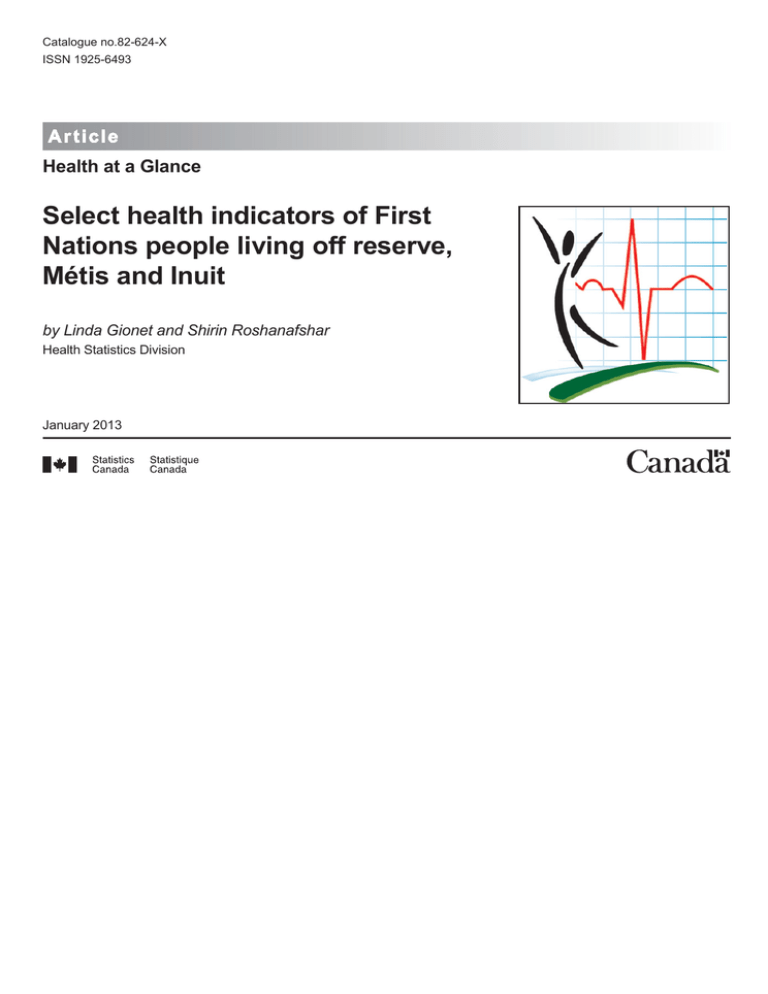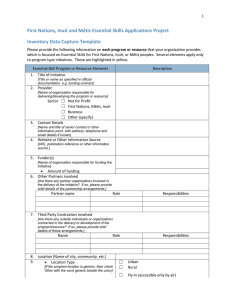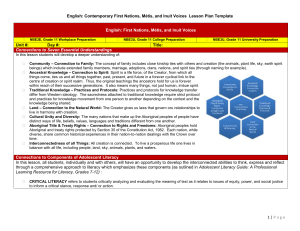
Catalogue no.82-624‑X
ISSN 1925-6493
A r t icl e
Health at a Glance
Select health indicators of First
Nations people living off reserve,
Métis and Inuit
by Linda Gionet and Shirin Roshanafshar
Health Statistics Division
January 2013
How to obtain more information
For information about this product or the wide range of services and data available from Statistics Canada, visit our website,
www.statcan.gc.ca.
You can also contact us by
email at infostats@statcan.gc.ca,
telephone, from Monday to Friday, 8:30 a.m. to 4:30 p.m., at the following toll-free numbers:
• Statistical Information Service
• National telecommunications device for the hearing impaired
• Fax line
Depository Services Program
• Inquiries line
• Fax line
1-800-263-1136
1-800-363-7629
1-877-287-4369
1-800-635-7943
1-800-565-7757
To access this product
This product, Catalogue no. 82-624-X, is available free in electronic format. To obtain a single issue, visit our website,
www.statcan.gc.ca, and browse by “Key resource” > “Publications.”
Standards of service to the public
Statistics Canada is committed to serving its clients in a prompt, reliable and courteous manner. To this end, Statistics Canada
has developed standards of service that its employees observe. To obtain a copy of these service standards, please contact
Statistics Canada toll-free at 1-800-263-1136. The service standards are also published on www.statcan.gc.ca under “About us” >
“The agency” > “Providing services to Canadians.”
Published by authority of the Minister responsible for
Statistics Canada
© Minister of Industry, 2013
All rights reserved. Use of this publication is governed by the
Statistics Canada Open Licence Agreement (http://www.
statcan.gc.ca/reference/licence-eng.htm).
Cette publication est aussi disponible en français.
Note of appreciation
Canada owes the success of its statistical system to a
long‑standing partnership between Statistics Canada, the
citizens of Canada, its businesses, governments and other
institutions. Accurate and timely statistical information could not
be produced without their continued co‑operation and goodwill.
Standard symbols
The following symbols are used in Statistics Canada
publications:
.
..
...
0
0s
not available for any reference period
not available for a specific reference period
not applicable
true zero or a value rounded to zero
value rounded to 0 (zero) where there is a meaningful
distinction between true zero and the value that was
rounded
p
preliminary
r
revised
x suppressed to meet the confidentiality requirements of the
Statistics Act
E
use with caution
F too unreliable to be published
* significantly different from reference category (p < 0.05)
Select health indicators of First Nations people living off reserve,
Métis and Inuit
Health at a Glance
Statistics Canada – Catalogue no. 82-624-X
by Linda Gionet and Shirin Roshanafshar
Highlights
• In 2007–2010, First Nations people living off reserve, Métis, and Inuit reported poorer
health compared with non-Aboriginal people. First Nations people1 and Métis were
more likely to report higher rates of chronic conditions compared with the nonAboriginal population.
• Smoking rates were over two times higher among the three Aboriginal groups than the
non-Aboriginal population. Aboriginal people were also twice as likely to be exposed to
second-hand smoke in the home.
• Aboriginal adults had higher obesity rates: First Nations people—26%; Inuit—26%;
and Métis—22%; compared to 16% for non-Aboriginal adults.
• All three Aboriginal groups were more likely to experience household food insecurity
than the non-Aboriginal population. The rates were 27% of Inuit, 22% of First Nations
people and 15% of Métis compared with 7% of non-Aboriginal people.
• Métis and First Nations people were more active during leisure time than their nonAboriginal counterparts. Inuit reported a stronger sense of belonging to their community
and a high satisfaction with life.
The health of First Nations people, Métis and
Inuit has been greatly affected by rapid societal
changes in the last half century.2 They face the
same health issues as the general population as
well as their own challenges. Monitoring the
health of Aboriginal groups, however, is limited
by a lack of data.
The Canadian Community Health Survey
(CCHS) provides a wealth of information
on many aspects of Canadians’ health, and
in recent years it included questions about
Aboriginal identity for First Nations people,
Métis and Inuit. The CCHS, however, was
not designed for these specific populations.
Furthermore, it does not include children under
12 years of age and its geographic coverage
excludes reserves, as well as some northern
and remote areas. Thus, the Health Statistics
Division evaluated CCHS data to determine
if it could be used to describe the health of
Aboriginal peoples.3
The evaluation compared CCHS questions
with similar ones from the Aboriginal Peoples
Survey, and found that both yielded similar
results. The evaluation also explored the number
of years of data that had to be combined to
produce health indicators at more detailed
levels—by age and sex. Four cycles, 2007 to
2010, were considered enough to yield reliable
estimates for most indicators.4
As a result, Statistics Canada combined the
CCHS data collected from 2007 to 2010
to create two data tables (CANSIM tables:
CANSIM table105-0512 and CANSIM
table105-0513). The tables cover a range of
3
Select health indicators of First Nations people
living off reserve, Métis and Inuit
Statistics Canada – Catalogue no. 82-624-X
Health at a Glance
Key demographics of the Aboriginal population: 2006 Census
• There were 1,172,790 people who identified themselves as an Aboriginal person— that is,
North American Indian (First Nations people), Métis and Inuit.5,6
• Within the Aboriginal population, 60% were First Nations people, 33% were Métis, 4%
were Inuit and 3% were of multiple or other Aboriginal identities.7
• Among First Nations people, 43%8 of them lived on reserve9,10 while the rest lived off
reserve.
• Most Inuit, 78%, lived in Inuit Nunangat (an Inuktitut expression for ‘Inuit homeland’),
which consists of four Inuit regions across the Arctic. Ontario and the western provinces
were home to 83% of First Nations people and 87% of Métis.8
• From 1996 to 2006, the First Nations population, both on and off reserve, grew 29%; the
Métis, 91% and Inuit, 26%.5 The growth of the Aboriginal population is partly because
more people self-identified as an Aboriginal person in 2006 than in 1996. This is especially
the case among Métis.11
• Aboriginal people are younger than the non-Aboriginal population. The median age of
First Nations people living off reserve was 26 years in 2006; of those on reserve, 25; Métis,
30; Inuit, 22; and non-Aboriginal people, 40.8
health indicators for First Nations people, Métis,
Inuit and the non-Aboriginal population; the
indicators are broken down further by sex, three
age groups, and by province and territory.
This article presents selected findings from this
CCHS dataset (2007 to 2010). Health data
for First Nations people, Métis and Inuit are
compared with the non-Aboriginal population
on a variety of topics. A subset of the results is
also featured in the List of Health Indicators.
Overall health
CCHS data revealed poorer self-reported
health among First Nations people, Métis, and
Inuit compared with non-Aboriginal people
(Chart 1). This is consistent with findings from
other surveys that focused on the Aboriginal
population.
4
Higher rates of chronic conditions partly
explain the poorer self-reported health among
First Nations people and Métis. Fifty six
percent of First Nations people and 55% of
Métis reported being diagnosed with one or
more chronic conditions, compared with 48%
of non-Aboriginal people.
Inuit (43%) were the least likely to report
having one or more diagnosed chronic
conditions. However, this may be partly due to
having less access to doctors who can diagnose
their conditions. According to the 2007-2010
CCHS, 83% of non-Aboriginal people have
a regular medical doctor, compared with 44%
of Inuit. In fact, most Inuit communities are
served by a nursing station only and accessing
hospital services can require extensive travel.12
Select health indicators of First Nations people
living off reserve, Métis and Inuit
Statistics Canada – Catalogue no. 82-624-X
Health at a Glance
Chart 1
Very good or excellent perceived health by Aboriginal and non-Aboriginal populations, aged 12
and over, Canada
percent
80
75
75
70
66
65
67
65
63
60
50
55
54
55
50
45
40
Health
Mental health
Perceived health
First Nations off reserve
Métis
Inuit
Non-Aboriginal
Notes:
1. The data were age standardized to the Aboriginal identity population, 2007-2010.
2. The difference between the estimate for each Aboriginal population and the estimate for the non-Aboriginal population is statistically
significant.
3. Inuit data do not include Nunavik and some remote communities.
Source: Statistics Canada, Canadian Community Health Survey 2007-2010.
Less access to doctors in the North (2006 Aboriginal Peoples Survey)
Inuit in Inuit Nunangat aged 15 years and older were more likely to have contact with a nurse
(70%) than with a family doctor or general practitioner (46%). Inuit living in the rest of Canada
were more likely to have contact with a family doctor or general practitioner (71%) than with a
nurse (39%).13
Certain diagnosed chronic conditions, such
as respiratory problems which are associated
with smoking, were more common among
the Aboriginal population than their nonAboriginal counterparts.14,15
All three groups had higher rates of asthma
(13-14%15) compared with the non-Aboriginal
population at 9%. Inuit, aged 25 to 44 years
had a particularly high rate of asthma at 22%.15
Asthma is a chronic disease that renders
breathing passages (airways) extra sensitive,
making breathing difficult. Poor indoor
air quality, ventilation and poor housing
conditions contribute to high rates of asthma
among Inuit.16
5
Select health indicators of First Nations people
living off reserve, Métis and Inuit
Statistics Canada – Catalogue no. 82-624-X
Health at a Glance
Housing conditions reported in the 2006 Census
Inuit were ten times more likely (31%) than non-Aboriginal people (3%) to live in crowded
homes—dwellings with more than one person per room—in Canada.
While Inuit have traditionally lived in multi-family groupings, a number of reports have suggested
that the high rate of families sharing a home may be due to the serious shortage of housing in
many communities throughout Inuit Nunangat.16
Inuit were four times more likely to live in homes in need of major repairs (28%) than nonAboriginal people (7%). Major repairs include defective plumbing or electrical wiring, as well as
structural repairs to walls, floors or ceilings.
First Nations people and Métis were also more
likely to report that chronic conditions or health
problems limited their ability to undertake some
activities than the non-Aboriginal population.
Health behaviours
Higher rates of daily smoking and heavy
drinking were reported by all three Aboriginal
groups than by the non-Aboriginal population.
First Nations people’s smoking rate was 32%;
Métis, 30%; and Inuit, 39%, compared with
15% among non-Aboriginal people (Chart 2).
Inuit youth aged 12 to 24 reported a rate of
33%, compared with 11% of non-Aboriginal
youth.
Inevitably, smoking also exposes non-smokers
to carcinogens that can lead to cancer, and
contributes to other diseases such as asthma,
heart disease and emphysema.17 All three groups
were more likely to be exposed to second-hand
smoke in the home, compared with 7% of nonAboriginal people. Métis youth, aged 12 to 24
years, experienced an especially high rate of
exposure at 24%.
Heavy drinking is also linked to a host of health
problems.18 All three groups were more likely
to drink heavily than non-Aboriginal people.
6
Focusing on heaving drinking, however, masks
a more complex reality. Among these groups,
for instance, there were high rates of people
who did not drink. That is, 34% of Inuit and
29% of First Nations people did not consume
alcohol in the past year compared with 24% of
non-Aboriginal people.
Non-Aboriginal people were less physically
active than Métis and First Nations people.19
In 2007–2010, 46% of non-Aboriginal people
were inactive during leisure time, compared
with 44% of First Nations people and 39% of
Métis.
Obesity
Obesity is recognized as a major public health
problem in Canada20 and the rates are high
among Aboriginal people.21 For adults aged
18 years and older,22 self-reported height and
weight were used to compute body mass index
(BMI) to explore obesity. The obesity rate for
First Nations people was 26%. It was 22%
for Métis, 26% for Inuit and 16% for nonAboriginal people (Chart 3). However, all
groups had similar rates for the overweight
category. Although BMI is commonly used to
assess a person’s weight, there is debate as to
whether the same cut-offs are appropriate for
Inuit.23,24,25
Select health indicators of First Nations people
living off reserve, Métis and Inuit
Health at a Glance
Statistics Canada – Catalogue no. 82-624-X
Chart 2
Select health behaviours by Aboriginal and non-Aboriginal populations, aged 12 and over, Canada
percent
60
49
50
44
39
40
32
30
46
39
30
26
27
26
19
20
15
10
0
Daily smoking
Heavy drinking
Inactive during leisure time
Health behaviour
First Nations off reserve
Métis
Inuit
Non-Aboriginal
Notes:
1. The data were age standardized to the Aboriginal identity population, 2007-2010.
2. The difference between the estimate for each Aboriginal population and the estimate for the non-Aboriginal population is statistically
significant.
3. Inuit data do not include Nunavik and some remote communities.
4. Heavy Drinking: Having five drinks or more on one occasion at least once a month during the past year.
5. Smoking: Current smokers who smoke daily.
6. Inactive during leisure time: average daily physical activity of respondents over the past 3 months has been used for this measure. Inactive
respondents are those where the sum of the average daily energy expenditures of all their leisure time activities is less than 1.5 kcal/kg/day.
Source: Statistics Canada, Canadian Community Health Survey 2007-2010.
Childhood and youth weight problems are a
particular challenge for Aboriginal people,whose
population is younger than the non-Aboriginal
population (see Key demographics). Métis
(28%) and First Nations (26%) youth aged
12 to 17 were more likely to be overweight or
obese than their non-Aboriginal counterparts
(19%).
Diabetes is one of many health issues related to
obesity.26 According to the Canadian Diabetes
Association, most people with diabetes are
overweight or obese, and Aboriginal people
face a high risk of developing the disease.27
Although diabetes was rare among the
Aboriginal population in North America prior
to 1940, it has now reached epidemic levels in
some communities.28,29 First Nations people,
in particular, were more likely to report being
diagnosed with diabetes than non-Aboriginal
people. This difference was most pronounced
for those 45 years and older, where 19% of
First Nations and 11% of the non-Aboriginal
population were diabetic.30
7
Select health indicators of First Nations people
living off reserve, Métis and Inuit
Health at a Glance
Statistics Canada – Catalogue no. 82-624-X
Chart 3
Percentage of population who are overweight or obese by Aboriginal and non-Aboriginal
populations, aged 18 and over, Canada
percent
35
32
31
32
32
30
26
26
25
22
20
16
15
10
5
0
First Nations off reserve
Métis
Inuit
Non-Aboriginal
Populations
Overweight
Obese
Notes:
1. The data were age standardized to the Aboriginal identity population, 2007-2010.
2. The difference between the estimate for each Aboriginal population and the estimate for the non-Aboriginal population is statistically
significant.
3. Inuit data do not include Nunavik and some remote communities.
4. Overweight: Repondents with self reported height and weight which resulted in BMI of 25 to 29.99.
5. Obese: Repondents with self reported height and weight which resulted in BMI of 30 or greater.
Source: Statistics Canada, Canadian Community Health Survey 2007-2010.
Household food insecurity
Food security is commonly understood to exist
in a household when all people, at all times,
have access to adequate, safe and nutritious
food.31 Conversely, food insecurity occurs when
food quality and/or quantity are compromised;
this is typically associated with limited financial
resources.32
Low-income families face many obstacles to
consuming a nutritious diet, including limited
access to fresh produce. Moreover, there tend to
be fewer grocery stores or farmers’ markets in
8
low-income neighbourhoods.33 These findings
are relevant for First Nations people, Métis and
Inuit, who had lower median incomes than the
non-Aboriginal population according to the
2006 Census.34,35
Health complications associated with food
insecurity can range from malnutrition to
obesity. Although it may seem contradictory,
people who experience food insecurity are
more likely to be obese. One possible reason is
that people with lower incomes may have less
access to affordable healthy food. Instead, they
consume low-cost, high calorie foods.36,37
Select health indicators of First Nations people
living off reserve, Métis and Inuit
Health at a Glance
Statistics Canada – Catalogue no. 82-624-X
Among First Nations people 12 and older,
22% lived in households that experienced food
insecurity, three times the proportion of nonAboriginal people at 7% (Chart 4). Fifteen
percent of Métis, and 27% of Inuit also lived
in food-insecure households. Food insecurity
was a problem for a larger percentage of First
Nations females (26%), than First Nations
males (16%). One contributing factor may be
that lone-parent families are more likely to
be headed by females and the percentages are
higher among the Aboriginal population.38
The high cost of food in the North contributes to
food insecurity. In most isolated communities,
it may cost $360 to $450 a week to provide a
nutritious diet for a family of four, compared
with about $200 to $250 in the South.39
Chart 4
Moderate or severe household food insecurity by Aboriginal and non-Aboriginal populations and
by sex, aged 12 and over, Canada
percent
30
28
27
26
Male
Female
25
20
17
16
14
15
8
10
7
5
0
First Nations off reserve
Métis
Inuit
Non -Aboriginal
Populations
Notes:
1. The data were age standardized to the Aboriginal identity population, 2007-2010.
2. The difference between the estimate for each Aboriginal population and the estimate for the non-Aboriginal population is statistically
significant.
3. Inuit data do not include Nunavik and some remote communities.
4. Food insecurity: indication of compromise in quality and/or quantity of food consumed or reduced food intake and disrupted eating patterns.
Source: Statistics Canada, Canadian Community Health Survey 2007-2010.
9
Select health indicators of First Nations people
living off reserve, Métis and Inuit
Statistics Canada – Catalogue no. 82-624-X
Health at a Glance
Life expectancy in Inuit Nunangat
Life expectancy in the Inuit regions (Inuit Nunangat) is 70.8 years. This is about 10 years lower
than in the rest of Canada where it is 80.6 years.40 Smoking-related causes of death contribute
significantly to the years of life lost—lung cancer and respiratory diseases account for 21% of all
deaths in Inuit Nunangat.41,42
Amidst the harsh conditions of living in
the North, Inuit maintain a strong sense
of community. Specifically, 81% of Inuit
reported a strong sense of belonging to their
local community compared with 65% of nonAboriginal people. The majority of Inuit (92%)
also reported they were satisfied with life,
similar to the rate for non-Aboriginal people
(93%), while First Nations people (89%) and
Métis (90%) reported lower rates.
Summary
The CCHS data reaffirmed that the health
profiles for Métis, Inuit and First Nations
people differs from the general population.43
Aboriginal people were more likely to report
having respiratory problems and other chronic
conditions. All three Aboriginal groups were
also more likely to report unhealthy behaviours,
namely smoking and heavy drinking compared
to the non-Aboriginal population.
Métis, Inuit and First Nations people had high
rates of obesity and household food insecurity.
Among specific groups, First Nations people’s
diabetes rates were particularly high for those
aged 45 and over. Inuit had the highest rates
of smoking and household food insecurity; and
Métis youth were more likely to be exposed to
second-hand smoke at home.
Linda Gionet and Shirin Roshanafshar are
analysts with the Health Statistics Division.
The authors wish to acknowledge Teresa Janz,
Brenda Wannell and Lawson Greenberg for
their contributions.
10
References
1. For the remainder of the article, the term “First
Nations people” refers to the First Nations
population living off reserve.
2. Public Health Agency of Canada. Diabetes in Canada:
Facts and Figures from a public health perspective.
Ottawa: Public Health Agency of Canada; 2011.
3. Roshanafshar S. Evaluating the Canadian
Community Health Survey data for Aboriginal
populations. Paper presented at: Health Data Users
Conference; September 10-11, 2012; Ottawa.
4. Even combining four survey cycles yielded very
limited data for Inuit because of the small population
size.
5. ‘Aboriginal identity’ refers to those persons who
reported identifying with at least one Aboriginal
group: North American Indian, Métis or Inuit, and/
or those who reported being a Treaty Indian or a
Registered Indian, as defined by the Indian Act of
Canada, and/or those who reported being members
of an Indian Band or First Nation. Source: Statistics
Canada. Aboriginal Statistics at a Glance, 2010.
Available at: http://www.statcan.gc.ca/pub/89-645x/89-645-x2010001-eng.htm. Accessed November
27, 2012.
6. More recent Aboriginal data from the 2011 National
Household Survey will be released in 2013.
7. Statistics Canada. Aboriginal identity population,
2006 counts, percentage distribution, percentage
change, 2006 counts for both sexes, for Canada,
provinces and territories - 20% sample data.
Aboriginal Peoples Highlight Tables, 2006 Census.
2009. Available at: http://www12.statcan.ca/censusrecensement/2006/dp-pd/hlt/97-558/pages/page.cf
m?Lang=E&Geo=PR&Code=01&Table=3&Data
=Count&Sex=1&StartRec=1&Sort=2&Display=Pa
ge. Accessed December 19, 2012.
Select health indicators of First Nations people
living off reserve, Métis and Inuit
Statistics Canada – Catalogue no. 82-624-X
8. Statistics Canada. 2006 Census: Aboriginal Peoples
in Canada in 2006: Inuit, Métis and First Nations,
2006 Census: Findings. 2006 Census: Analysis Series.
2009. Available at: http://www12.statcan.ca/censusrecensement/2006/as-sa/97-558/index-eng.cfm.
Accessed November 27, 2012.
9. The ‘on-reserve’ population is defined according
to criteria established by Aboriginal Affairs and
Northern Development Canada (AANDC).
For a detailed definition, see the 2006 Census
Dictionary: Statistics Canada. More information
on Census subdivision (CSD). 2011. Available at:
http://www12.statcan.gc.ca/censusrecensement/2006/ref/dict/geo012a-eng.cfm.
Accessed November 27, 2012.
10. Some Indian reserves and settlements did not
participate in the census as enumeration was not
permitted, or it was interrupted before completion.
11. This phenomenon is akin to ‘ethnic mobility’, where
there are “changes over time in the ethnic identity
that individuals report.” Source: Guimond, É. Ethnic
mobility and the demographic growth of Canada’s
Aboriginal populations from 1986 to 1996. Report
on the Demographic Situation in Canada. Statistics
Canada Catalogue no. 91-209-X. Issue 1998 and
1999, 195-209.
12. Pauktuutit-Inuit Women of Canada. Health. 2012.
Available at: http://pauktuutit.ca/health/. Accessed
November 27, 2012.
13. Statistics Canada. 2006 Profile of Aboriginal
Children, Youth and Adults: Key indicators from the
2006 Aboriginal Children’s Survey and the 2006
Aboriginal Peoples Survey. 2009. Available at: http://
www12.statcan.gc.ca/census-recensement/2006/
dp-pd/89-635/index.cfm?LANG=eng&fpv=10000.
Accessed December 20, 2012.
14. Within the CCHS, respiratory problems include
asthma, chronic bronchitis, emphysema and chronic
obstructive pulmonary disease.
15. The Inuit statistic should be used with caution.
16. Knotsch C, Kinnon D. If not now.when? Addressing
the ongoing Inuit housing crisis in Canada. Ottawa:
National Aboriginal Health Organization; 2011.
Health at a Glance
17. Health Canada. Second-hand Smoke. Health
Concerns. 2009. Available at: http://www.hc-sc.
gc.ca/hc-ps/tobac-tabac/second/index-eng.php.
Accessed November 28, 2012.
18. Health Canada. Responsible Drinking. Healthy
Living. 2012. Available at: http://www.hc-sc.
gc.ca/hl-vs/iyh-vsv/life-vie/drink-boire-eng.php.
Accessed November 28, 2012.
19. Respondents’ leisure-time physical activity was based
on a list of common activities. This list, however, was
designed for the total Canadian population and may
not include activities that are more relevant to the
Aboriginal population. For instance, the Aboriginal
Peoples Survey includes the following activities
that are not listed in the CCHS, namely: hunting/
trapping, canoeing or berry picking.
20. Public Health Agency of Canada and the Canadian
Institute for Health Information. Obesity in Canada.
Ottawa: Government of Canada; 2011.
21. According to Willows, “The ominous chronic
disease profile among Aboriginal people in
Canada highlights an urgent need for effective,
culturally appropriate obesity prevention strategies.”
Source: Willows ND, Hanley AJ, Delormier T. A
socioecological framework to understand weightrelated issues in Aboriginal children in Canada. Appl
Physiol Nutr Metab. 2012;37(1):1-13.
22. Age groupings for obesity differ from the other
health indicators in the article.
23. Charbonneau-Roberts G, Saudny-Unterberger
H, Kuhnlein HV, et al. Body mass index may
overestimate the prevalence of overweight and
obesity among the Inuit. Int J Circumpolar Health.
2005;64(2):163-9.
24. Young TK, Bjerregaard P, Dewailly E, et al.
Prevalence of obesity and its metabolic correlates
among circumpolar Inuit in 3 countries. Am J Public
Health. 2007;97(4):691-5
25. Lear SA, Humphries KH, Frohlich JJ, et al.
Appropriateness of current thresholds for obesityrelated measures among Aboriginal people. Can
Med Assoc J. 2007;177(12):1499-1505.
11
Select health indicators of First Nations people
living off reserve, Métis and Inuit
Statistics Canada – Catalogue no. 82-624-X
Health at a Glance
26. Monash University. Critical link between obesity
and diabetes discovered. Science Daily. 2009.
Available at: http://www.sciencedaily.com/
releases/2009/07/090708090917.htm. Accessed on
November 27, 2012.
35. Median total income includes earnings from all
sources including employment income as well as
government transfers. The median income is the
middle value where half of the specified population
earns more and half the population earns less.
27. Canadian Diabetes Association. Research. Diabetes
in special populations. 2012. Available at: http://www.
diabetes.ca/research/specialpopulations/. Accessed
November 29, 2012.
36. Willows ND, Hanley AJG, Delormier T. A
socioecological framework to understand weightrelated issues in Aboriginal children in Canada. See
reference in note no. 21.
28. Young TK, Reading J, Elias B, et al. Type 2
diabetes mellitus in Canada’s First Nations: status
of an epidemic in progress. Can Med Assoc J.
2000;163(5):561-566.
37. Blackwell
Publishing
Ltd.
Lower-income
Neighbourhoods Associated with Higher Obesity
Rates. Science Daily. 2008. Available at: http://www.
sciencedaily.com/releases/2008/02/080207163807.
htm. Accessed November 29, 2012.
29. Bruce S. Prevalence and determinants of diabetes
mellitus among Métis of western Canada. Amer J
Hum Biol. 2000;12(4):542-551.
30. Inuit rate of diabetes for this age group is not
statistically different from the rate among nonAboriginal people.
31. Food and Agricultural Organization. Rome
Declaration on World Food Security and World Food
Summit Action Plan. 1996. Available at: http://
www.fao.org/docrep/003/w3613e/w3613e00.htm.
Accessed November 29, 2012.
32. Tarasuk V. Health Implications of Food Insecurity.
Social Determinants of Health: Canadian Perspectives.
Second Edition. Toronto: Canadian Scholar’s Press;
2009, Chapter 14.
33. Milway J, Chan K, Stapleton, J. et al. The poor still
pay more: Challenges low income families face in
consuming a nutritious diet. Toronto: Insitute for
Competitiveness and Prosperity: Open Policy
Toronto; 2010.
34. According to the 2006 Census, the median total
incomes were $27,728 for Métis, $24,782 for Inuit
and $19,114 for First Nations people (both on
and off reserve) compared with $33,394 among
non-Aboriginal people. Source: Statistics Canada,
Aboriginal Statistics at a Glance. See reference in note
no. 5.
12
38. In the 2006 Census, 35% of First Nations children
living off reserve (aged 14 and under) were in a
family with a lone-parent female compared with 6%
who were headed by a lone-parent male. Among the
non-Aboriginal population, 14% of non-Aboriginal
children were raised by lone-parent females
compared with 3% raised by lone-parent males.
Source: Statistics Canada. 2006 Census: Aboriginal
Peoples in Canada in 2006: Inuit, Métis and First
Nations, 2006 Census: Findings. See reference in
note no. 8.
39. Aboriginal Affairs and Northern Development
Canada. Revised Northern Food Basket - Highlights
of Price Survey Results for 2006,2007 and 2008.
Food Cost. December 19, 2008. Available at: http://
www.aadnc-aandc.gc.ca/eng/1100100035941/1100
100035942. Accessed November 29, 2012
40. Statistics Canada. Table 102-0406: Life expectancy,
at birth and at age 65, by sex, five-year average,
Canada and Inuit regions. CANSIM. 2012. Available
at:
http://www5.statcan.gc.ca/cansim/pick-ch
oisir?lang=eng&p2=33&id=1020706.
Accessed
December 10, 2012.
41. Data on life expectancy, cancer and respiratory
problems in the Inuit regions, include both Inuit
and non-Inuit.
Select health indicators of First Nations people
living off reserve, Métis and Inuit
Statistics Canada – Catalogue no. 82-624-X
42. From 2004 to 2008, there were 1,210 deaths in the
Inuit regions. Of those, 123 were caused by lung cancer
and 136 by respiratory diseases. Source: Statistics
Canada. Table 102-0407: Mortality, by selected causes
of death (ICD-10) and sex, five-year average, Canada
and Inuit regions. CANSIM. 2010. Available at:
http://www5.statcan.gc.ca/cansim/a26?lang=eng&r
etrLang=eng&id=1020704&paSer=&pattern=&stB
yVal=1&p1=1&p2=-1&tabMode=dataTable&csid=.
Accessed December 10, 2012.
Health at a Glance
43. Garner R, Carrière G, Sanmartin C, et al. The
Health of First Nations Living Off-Reserve, Inuit and
Métis Adults in Canada: The Impact of Socio-economic
Status on Inequalities in Health. Health Research
Working Paper Series. Statistics Canada Catalogue
no. 82‑622-X–No. 004. Ottawa: Statistics Canada;
2010
13
Select health indicators of First Nations people
living off reserve, Métis and Inuit
Statistics Canada – Catalogue no. 82-624-X
Health at a Glance
Appendix 1
List of Health Indicators by Aboriginal and non-Aboriginal populations
Health Indicator
First Nations
Off reserve
Métis
Inuit Non-Aboriginal
percent
General Health
Perceived health, very good or excellent
Perceived health, fair or poor
Perceived mental health, very good or excellent
Perceived mental health, fair or poor
Life satisfaction, satisfied or very satisfied
Perceived life stress, quite a lot (15 years and over)
Participation and activity limitation, sometimes or often
50*
16*
66*
8*
89*
24
33*
54*
13*
67*
8*
90*
25
33*
55*
8
65*
5E
92
19
30
63
9
75
5
93
23
26
Chronic conditions
One or more chronic conditions
Arthritis
Asthma
Diabetes
High blood pressure
Mood disorder
Respiratory problems
High blood pressure, heart disease, or suffering from effects of stroke
Pain or discomfort, moderate or severe
Pain or discomfort that prevents activities
56*
14*
14*
6*
9*
12*
15*
11*
14*
15*
55*
14*
13*
4
9*
10*
15*
10*
14*
16*
43
10E
14E
2E*
7*
5E
15E
9E
9E
11
48
12
9
4
12
6
10
14
10
10
Health behaviours
Influenza immunization, less than one year ago
Breastfeeding initiation
Exclusive breastfeeding (at least 6 months)
Current smoker, daily or occasional
Current smoker, daily
Five or more drinks on one occasion (at least once a month in the past year)
Never had any alcoholic drinks in the past 12 months
Fruit and vegetable consumption (5 times or more per day)
Physically active during leisure time, moderately active or active
Physically inactive during leisure time
Contact with a medical doctor (in the past 12 months)
Has a regular medical doctor
Obese (18 years and over)
Overweight (18 years and over)
Overweight or obese (18 years and over)
Overweight or obese (12 to 17 years)
27
82*
19
40*
32*
26*
29*
36*
56*
44*
74*
78*
26*
31
57*
26*
22*
78*
14*
36*
30*
27*
23
39*
61*
39*
76
80*
22*
32
54*
28*
31
77*
26E
48*
39*
26*
34*
27*
51
49
62*
44*
26*
32
58*
25E
27
88
25
21
15
19
24
45
54
46
78
83
16
32
48
19
Exposure to second-hand smoke
In vehicles and/or public places (in the past month)
At home
In public places (in the past month)
In vehicles (in the past month)
25*
15*
15*
16*
31*
16*
18*
20*
24E
17E*
13E
18E*
17
7
12
9
Other
Sense of belonging to local community, somewhat strong or very strong
Food Insecurity
63
22*
63
15*
81*
27*
65
7
E use with caution
*
significantly different from reference category (p < 0.05). For this table, the reference category is “Non-Aboriginal”
Notes:
1. The Aboriginal population is younger than the non-Aboriginal population. To account for this, the data were age standardized to the
Aboriginal identity population 2007-2010.
2. The survey does not capture all diagnosed chronic conditions. Certain diagnosed chronic conditions are not shown because their prevalences
were too low or the data were not collected in the survey.
3. Inuit data do not include Nunavik and some remote communities.
Source: Canadian Community Health Survey, combined 2007 to 2010 cycles. Please refer to CANSIM tables 105-0512 and 105-0513
(age standardized).
14





